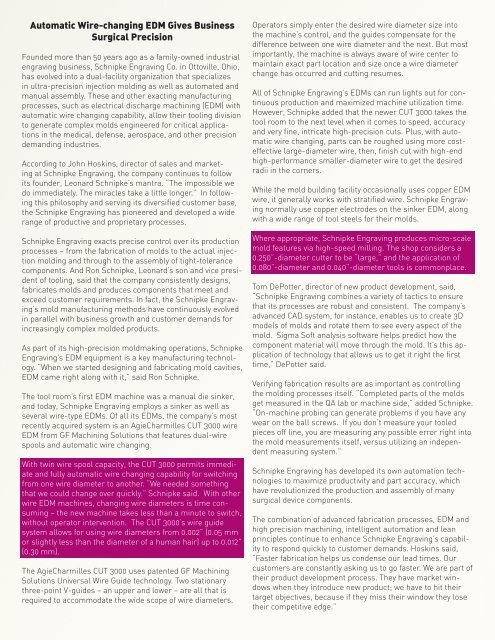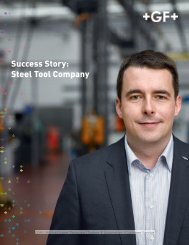You also want an ePaper? Increase the reach of your titles
YUMPU automatically turns print PDFs into web optimized ePapers that Google loves.
Automatic Wire-changing EDM Gives Business<br />
Surgical Precision<br />
Founded more than 50 years ago as a family-owned industrial<br />
engraving business, <strong>Schnipke</strong> <strong>Engraving</strong> <strong>Co</strong>. in Ottoville, Ohio,<br />
has evolved into a dual-facility organization that specializes<br />
in ultra-precision injection molding as well as automated and<br />
manual assembly. These and other exacting manufacturing<br />
processes, such as electrical discharge machining (EDM) with<br />
automatic wire changing capability, allow their tooling division<br />
to generate complex molds engineered for critical applications<br />
in the medical, defense, aerospace, and other precision<br />
demanding industries.<br />
According to John Hoskins, director of sales and marketing<br />
at <strong>Schnipke</strong> <strong>Engraving</strong>, the company continues to follow<br />
its founder, Leonard <strong>Schnipke</strong>’s mantra. “The impossible we<br />
do immediately. The miracles take a little longer.” In following<br />
this philosophy and serving its diversified customer base,<br />
the <strong>Schnipke</strong> <strong>Engraving</strong> has pioneered and developed a wide<br />
range of productive and proprietary processes.<br />
<strong>Schnipke</strong> <strong>Engraving</strong> exacts precise control over its production<br />
processes – from the fabrication of molds to the actual injection<br />
molding and through to the assembly of tight-tolerance<br />
components. And Ron <strong>Schnipke</strong>, Leonard’s son and vice president<br />
of tooling, said that the company consistently designs,<br />
fabricates molds and produces components that meet and<br />
exceed customer requirements. In fact, the <strong>Schnipke</strong> <strong>Engraving</strong>’s<br />
mold manufacturing methods have continuously evolved<br />
in parallel with business growth and customer demands for<br />
increasingly complex molded products.<br />
As part of its high-precision moldmaking operations, <strong>Schnipke</strong><br />
<strong>Engraving</strong>’s EDM equipment is a key manufacturing technology.<br />
“When we started designing and fabricating mold cavities,<br />
EDM came right along with it,” said Ron <strong>Schnipke</strong>.<br />
The tool room’s first EDM machine was a manual die sinker,<br />
and today, <strong>Schnipke</strong> <strong>Engraving</strong> employs a sinker as well as<br />
several wire-type EDMs. Of all its EDMs, the company’s most<br />
recently acquired system is an AgieCharmilles CUT 3000 wire<br />
EDM from GF Machining Solutions that features dual-wire<br />
spools and automatic wire changing.<br />
With twin wire spool capacity, the CUT 3000 permits immediate<br />
and fully automatic wire changing capability for switching<br />
from one wire diameter to another. “We needed something<br />
that we could change over quickly.” <strong>Schnipke</strong> said. With other<br />
wire EDM machines, changing wire diameters is time consuming<br />
– the new machine takes less than a minute to switch,<br />
without operator intervention. The CUT 3000’s wire guide<br />
system allows for using wire diameters from 0.002” (0.05 mm<br />
or slightly less than the diameter of a human hair) up to 0.012”<br />
(0.30 mm).<br />
The AgieCharmilles CUT 3000 uses patented GF Machining<br />
Solutions Universal Wire Guide technology. Two stationary<br />
three-point V-guides – an upper and lower – are all that is<br />
required to accommodate the wide scope of wire diameters.<br />
Operators simply enter the desired wire diameter size into<br />
the machine’s control, and the guides compensate for the<br />
difference between one wire diameter and the next. But most<br />
importantly, the machine is always aware of wire center to<br />
maintain exact part location and size once a wire diameter<br />
change has occurred and cutting resumes.<br />
All of <strong>Schnipke</strong> <strong>Engraving</strong>’s EDMs can run lights out for continuous<br />
production and maximized machine utilization time.<br />
However, <strong>Schnipke</strong> added that the newer CUT 3000 takes the<br />
tool room to the next level when it comes to speed, accuracy<br />
and very fine, intricate high-precision cuts. Plus, with automatic<br />
wire changing, parts can be roughed using more costeffective<br />
large-diameter wire, then, finish cut with high-end<br />
high-performance smaller-diameter wire to get the desired<br />
radii in the corners.<br />
While the mold building facility occasionally uses copper EDM<br />
wire, it generally works with stratified wire. <strong>Schnipke</strong> <strong>Engraving</strong><br />
normally use copper electrodes on the sinker EDM, along<br />
with a wide range of tool steels for their molds.<br />
Where appropriate, <strong>Schnipke</strong> <strong>Engraving</strong> produces micro-scale<br />
mold features via high-speed milling. The shop considers a<br />
0.250”-diameter cutter to be “large,” and the application of<br />
0.080”-diameter and 0.040”-diameter tools is commonplace.<br />
Tom DePotter, director of new product development, said,<br />
“<strong>Schnipke</strong> <strong>Engraving</strong> combines a variety of tactics to ensure<br />
that its processes are robust and consistent. The company’s<br />
advanced CAD system, for instance, enables us to create 3D<br />
models of molds and rotate them to see every aspect of the<br />
mold. Sigma Soft analysis software helps predict how the<br />
component material will move through the mold. It’s this application<br />
of technology that allows us to get it right the first<br />
time,” DePotter said.<br />
Verifying fabrication results are as important as controlling<br />
the molding processes itself. “<strong>Co</strong>mpleted parts of the molds<br />
get measured in the QA lab or machine side,” added <strong>Schnipke</strong>.<br />
“On-machine probing can generate problems if you have any<br />
wear on the ball screws. If you don’t measure your tooled<br />
pieces off line, you are measuring any possible error right into<br />
the mold measurements itself, versus utilizing an independent<br />
measuring system.”<br />
<strong>Schnipke</strong> <strong>Engraving</strong> has developed its own automation technologies<br />
to maximize productivity and part accuracy, which<br />
have revolutionized the production and assembly of many<br />
surgical device components.<br />
The combination of advanced fabrication processes, EDM and<br />
high precision machining, intelligent automation and lean<br />
principles continue to enhance <strong>Schnipke</strong> <strong>Engraving</strong>’s capability<br />
to respond quickly to customer demands. Hoskins said,<br />
“Faster fabrication helps us condense our lead times. Our<br />
customers are constantly asking us to go faster. We are part of<br />
their product development process. They have market windows<br />
when they introduce new product; we have to hit their<br />
target objectives, because if they miss their window they lose<br />
their competitive edge.”
















